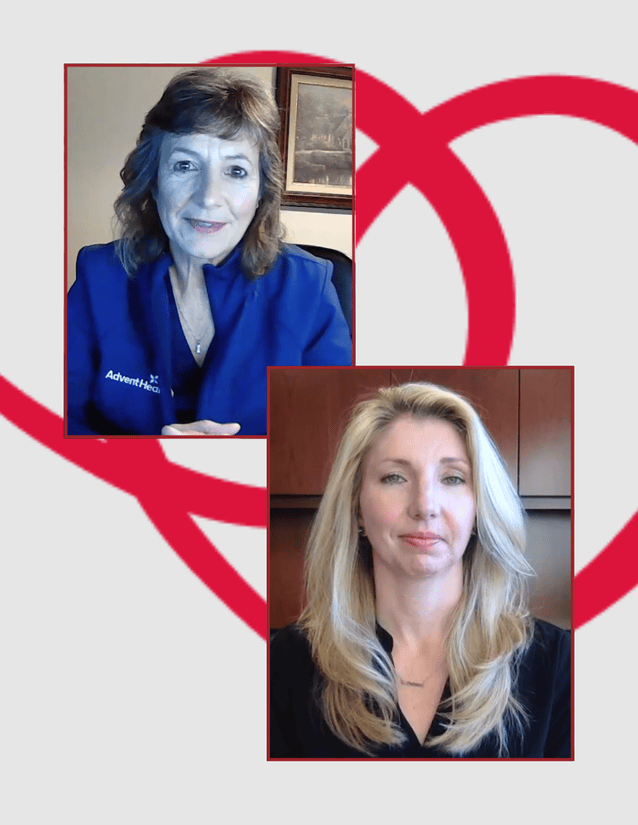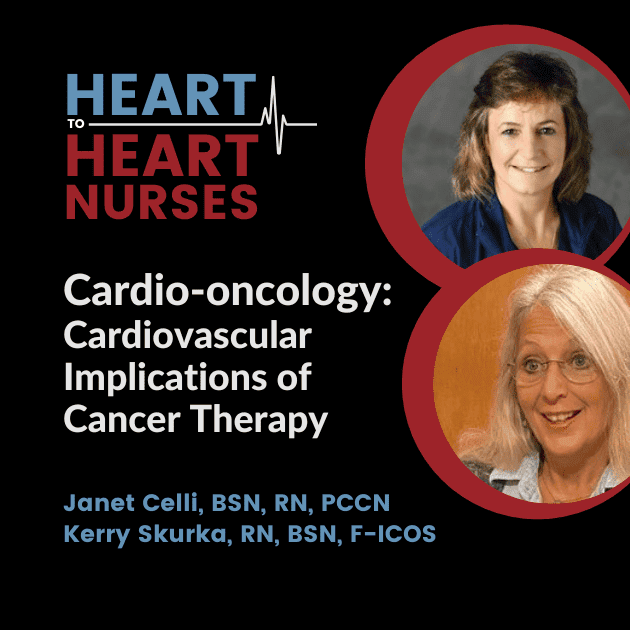Cardiovascular Implications of Cancer Therapy
A relatively new field, and a fast-growing subspecialty, cardio-oncology addresses cardiovascular disease, or side effects, associated with cancer. Guests Janet Celli, BSN, RN, PCCN, and Kerry Skurka, RN, BSN, F-ICOS, discuss the clinical implications for patients who may experience cardiovascular disease during, or following, cancer treatment.
Thank you to the Bristol-Myers Squibb – Pfizer Alliance for supporting this episode.
Episode Resources
Welcome to Heart to Heart Nurses, brought to you by the Preventive Cardiovascular Nurses Association. PCNA’s mission is to promote nurses as leaders in cardiovascular disease prevention and management.
Geralyn Warfield (host): In today’s episode, we’re going to be discussing cardiovascular disease in cancer patients. And I’d really like to thank our two guests, Kerry Skurka, and Janet Celli, for being with us today. Kerry, could you please introduce yourself? And then we’ll have Janet introduce herself.
Kerry Skurka (guest): Hi, my name is Kerry Skurka and I am a cardio-oncology nurse. I have been a cardiac and an oncology nurse for a long time in my history of nursing professions. However, in 2016, I started this brand new subspecialty and became a cardio-oncology nurse navigator.
Geralyn Warfield (host): So, Janet, could you introduce yourself to our audience, please?
Janet Celli (guest): Yes, my [00:01:00] name is Janet Celli, and I am a critical care nurse out of Advent Health in Orlando. And I started my career back in 1986 in Boston, Massachusetts with a couple years of experience in oncology initially, and then transferred over to cardiology for the remaining several years.
In 2019, I was blessed to be offered a job that actually linked both of the careers that I had been involved in, in my nursing career, in cardio-oncology, I had not heard of cardio-oncology prior to that, but it has been a tremendous blessing to be able to help with preventative medicine, with patients in the field that we’re in.
Geralyn Warfield (host): Well, our audience can probably tell already that we have a lot of great talent on the podcast today. So, let’s go ahead and get started. And Kerry, I’m wondering if you could help us understand the basics of what do we really mean when we say the words cardio-oncology?
Kerry Skurka (guest): Well cardio-oncology is a [00:02:00] new subspecialty. Actually, the American College of Cardiology gave it its own section as cardio-oncology in 2016, which is when I started in the field. And, basically, it’s going to be one of the largest, and is now the fastest growing subspecialty that you’re going to see, because what it is, it is a field where we look at the cardiovascular side effects or disease, that can affect cancer patients as they go through oncology treatment
And we look at them from the beginning, before they go into it, trying to make sure that they’re managing their comorbidities the best they can before they start their treatment. Then we try and mitigate any side effects that might happen through the course of their oncology treatment. And then, in [00:03:00] survivorship, we help to help them to have the best quality of life. Also trying to help them manage any side effects or long-term effects that might have occurred from cancer.
Geralyn Warfield (host): Janet. I’m wondering if you might be able to lead us through a little bit of history when it comes to the treatment for cancer patients.
Janet Celli (guest): Yes, absolutely. As, as many of you may know, anthracyclines have been around for quite some time. In the 1960s. they originated in, in Europe, in Italy in fact, and have been very successful in treating childhood leukemias and solid tumors, lung, GI and, and breast cancers.
And in the, in the late 1980s, early 1990s, we started to see cancer survivors present to cardiologists with cardiovascular symptoms, such as congestive heart failure. So, although these are very successful treatments with cancers, we started to realize in the early [00:04:00] 1990s that we had to actually monitor patients for the long-term effects of congestive heart failure, and cardiovascular symptoms. Because our mission is to make sure we’re successfully get allowing our patients to complete the therapy, but we don’t want them to succumb to potential cardiovascular side effects from the chemo.
Geralyn Warfield (host): So, based on what you’ve just described, I’d like us to, if we may dive just a little bit deeper into the chronicity of many cancers today, and I think we all recognize that thanks to changes that have happened in cancer treatments, that a lot of our cancer patients actually have much longer lifespans than they did 30 or 50 years ago. And, what are those cardiovascular complications or implications, I guess I should say, of that kind of treatment? Kerry, perhaps you could start.
Kerry Skurka (guest): Well first, I, I think I’ll, I’ll just talk a little bit about the chronicity of cancer, because, you know, we first started with radiation therapy back in the 1920s, [00:05:00] and then we went to chemotherapy, and from that, and that was basically to kill cancer cells. And then from the next piece that happened, we started, research and development got us to the place where there was targeted therapy, which was directed specifically at cancer cells. And then from there we have moved to the place of immunotherapy, where we are recruiting a patient’s own immune system to kill cancer cells.
And as I say, “kill cancer cells,” you know, we have a wonderful body. And while we may, say, try and focus on cancer cells, the other place that we end up having issues with, is the side effects from them targeting cancer cells. And that ends up bringing us to a lot of cardiovascular effects because the two—cardiovascular system and the cancers that occur—often have the same cells. And therefore, you end up with several different kinds of cardiovascular side effects.
Probably the one, as Janet alluded to, related to anthracyclines—or the “red devil” as if, a lot of times, if you, a patient doesn’t remember you just say, “Did you get a red? Did you get a red drug when you were going?” (Because it’s red.) And it did cause, decrease cardiac out…cardiac function, like heart failure. And that was probably one of the first ones.
Then we also see anthracyclines, they can also cause arrhythmias; there’s other ones that can cause hypertension is a big one; they can also cause valvular disease. So, there’s a lot of them [side effects] that can happen [00:07:00] from that [anthracyclines]. I think Janet, you have a recent event with a patient of yours who was getting anthracyclines. Would you like to share about that? I thought that was a good story.
Janet Celli (guest): Yes. I, if I can supplement what Kerry also said with the anthracycline, she mentioned Adriamycin®. And receiving a larger dose of Adriamycin® can also affect an outcome; if somebody’s received more than 450 mg/m2, that would be a red, red flag for potentially putting somebody at high risk for cardiovascular side effects.
And, also, anthracyclines paired with HER2 therapies. Herceptin, and Perjeta®, are also drugs that we would look at if somebody is getting Anthracycline and Herceptin and Perjeta®, those would put people in a higher category, a higher risk category for, for cardiac side effects.
And as Kerry mentioned, [00:08:00] If I can just bring into light, what we do in our program is echocardiograms, but we do instead of a 2D echocardiogram, we do a 3D with GLS strain echo. And what that would give us is a specific number instead of a range. For example, in a traditional 2D echocardiogram, you would get a range possibly of 50 to 55% or 55 to 60% for ejection fraction.
If we look at a 3D echo, it would give us a specific number, and anything less than 53% would be a red flag for me for ejection fraction. And the other, the other important factor for a 3D strain is, it gives us global longitudinal strain, which is something I also look at—and that’s actually the strain on the myocardium.
So, if somebody has a negative, inverse number, that’s less than 17 (-17) [00:09:00] – in other words, if it’s -16—that would be a red flag for me. And what I, what Kerry was alluding to is, I had a patient that just recently this past week had a, an EF of 56%, which is not unusual. A cardiologist would look at that and say, that’s perfectly normal—but we had a GLS on that patient that was below 17. It was actually -10. So that was a red flag for me.
And that’s the type of technology that we are thankful for to look at, looking at, echocardiograms. We can be preventative and catching long-term symptoms, cardiovascular symptoms, and really flag the oncologist and make sure that we make a cardiologist aware of that. Because we want to make sure patients successfully get through their therapies. We want to really kind of be preventative in making sure the, that the heart disease isn’t something that we, that we miss in the, in the bigger picture. [00:10:00]
Geralyn Warfield (host): Thank you both so much for that great information about cardio-oncology—a little bit of historical background on what cardio-oncology is, what we do, and how it might affect the cardiovascular system. We’re going to take a real quick break and we will be right back.
Geralyn Warfield (host): We’re back with Kerry Skurka and Janet Celli talking about cardio-oncology. And I’m wondering if we could dive just a little bit deeper into another kind of therapy, which most of us are familiar with in addition to some of those chemo toxic, perhaps, agents that are being used, but what about radiation and how does that affect the risk for cardiovascular disease or those cells? We’ve kind of alluded to that, but I’d love us to spend just a little bit of time on that. Janet, would you like to take that question first?
Janet Celli (guest): Yeah. Thank you, Geralyn. If, if we’re looking at any type of radiation to the left side of the chest, it would be, it would be something that we want to be made aware of. Anything that’s greater than 30 gray, in the heart field itself, can [00:11:00] really cause, or really put somebody in a higher risk, for cardiovascular complications afterwards.
So, if you’re talking about left-sided breast cancer, or perhaps a tumor that’s on the left side of the lung, or anything that’s affecting the left side of the chest, that’s something we definitely want to be aware of, and follow that patient long-term for any long-term effects, cardiovascular effects, whether it be acute coronary syndromes, or atherosclerosis or a thrombus. Those are, those are definitely some of the things to be aware of, looking at that patient. Historically, making sure we follow up with them. If they have any symptomatology that that would warrant further evaluation.
Kerry Skurka (guest): I think I would also add to it that, also the mediastinal area is also one that is involved. And, so there, you can see a lot of Hodgkins. Patients tend to have mantle [00:12:00] radiation as well as, Janet talked about the left side, and breast cancer, for sure. But you can have lung cancer also. And, looking at mediastinal, you can also have esophageal cancer. Those are areas where radiation, and as she alluded to, you can definitely have all of those side effects, like she mentioned.
I think I saw, my first realization was when I was doing open heart and someone said, “Oh, I had, breast cancer a long time ago.” And so those are the types of side effects that we’re trying to stop with cardio-oncology.
Geralyn Warfield (host): As we’ve learned today, cardio-oncology is quite a complex field and there is definitely a lot to learn. Are there some resources that our listeners could access, if they have questions about what’s been discussed today? Perhaps, Kerry, you could start with some potential resources.
Kerry Skurka (guest): I think that, you [00:13:00] can…one of a…a really good resource for patients’ education is the American College of Cardiology CardioSmart. They have a section about how cancer can affect your heart. And I think it’s a resource that isn’t seen very often because most cancer patients don’t realize that this is something that can happen, and they have some great educational tools as well as ways that they can help themself.
Janet Celli (guest): And if I can supplement what Carrie just mentioned, We, as nurses, ICOS, the ICOS actually is a great format for…Cardio-Oncology Society…and it is an international group that, every Thursday from 9:00 AM to 10:00 AM, has great informational topics. And, thanks to the pandemic, it’s something that you can [00:14:00] just sign on to, and join ICOS, and be part of journal clubs.
It’s a webinar format and really offers a great opportunity to see what’s going on—really, around the world—with benchmarking our care for patients; and doing our very best to deliver excellent care, and collaborate with, with nurses and doctors from, as I mentioned, all around the world.
Kerry Skurka (guest): I think also you can go to the Cancer Support Community. They have good resources there for patients as well as the Association for Cancer Community Centers. These would be other places that you might, might find some education for your patients.
Geralyn Warfield (host): Well, we certainly have learned a lot about cardio-oncology today in our first of three episodes. And if you join us next time, we are going to be building on our discussion that we had today, talking about the side effects from chemo toxicity from cancer [00:15:00] treatments. In our next episode, we’ll be discussing additional side effects: arrhythmias, atherosclerosis, hypertension, and thromboemboli.
We look forward to seeing you then. In the meantime, this is your host Geralyn Warfield, and we will see you then.
Janet Celli (guest): Thank you.
Thank you for listening to Heart to Heart Nurses. We invite you to visit pcna.net for clinical resources, continuing education, and much more.
Topics
- Cardio-Oncology
Published on
July 5, 2022
Listen on:
BSN, RN, PCCN
RN, BSN, F-ICOS
Related Resources







